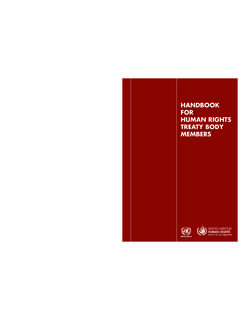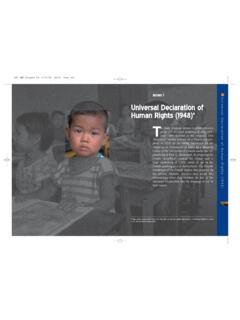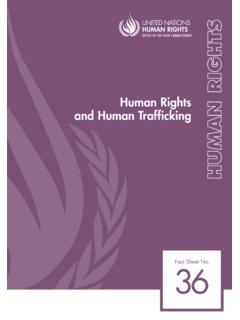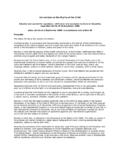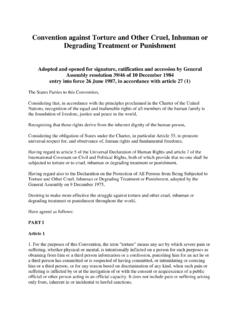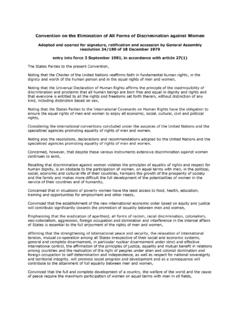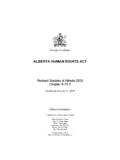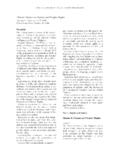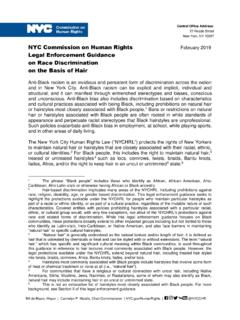Transcription of HUMAN RIGHTS INDICATORS - ohchr.org
1 HUMAN RIGHTS . INDICATORS . A Guide to Measurement and Implementation Note The designations employed and the presentation of the material in this publication do not imply the expression of any opinion whatsoever on the part of the Secretariat of the United Nations concerning the legal status of any country, territory, city or area, or of its authorities, or concerning the delimitation of its frontiers or boundaries. Symbols of United Nations documents are composed of capital letters combined with figures. Mention of such a figure indicates a reference to a United Nations document. HR/PUB/12/5. 2012 United Nations All worldwide RIGHTS reserved HUMAN RIGHTS . INDICATORS . A Guide to Measurement and Implementation New York and Geneva, 2012. The Office of the United Nations High Commissioner for HUMAN RIGHTS (OHCHR) is mandated to promote and protect the enjoyment and full realization, by all people, of all RIGHTS established in the Charter of the United Nations and in international HUMAN RIGHTS laws and treaties.
2 It is guided in its work by the mandate provided by the General Assembly in resolution 48/141, the Charter of the United Nations, the Universal Declaration of HUMAN RIGHTS and subsequent HUMAN RIGHTS instruments, the Vienna Declaration and Programme of Action of the 1993 World Conference on HUMAN RIGHTS , and the 2005 World Summit Outcome Document. The mandate includes preventing HUMAN RIGHTS violations, securing respect for all HUMAN RIGHTS , promoting international cooperation to protect HUMAN RIGHTS , coordinating related activities throughout the United Nations, and strengthening and streamlining United Nations HUMAN RIGHTS work. In addition to its mandated responsibilities, it leads efforts to integrate a HUMAN RIGHTS approach within all work carried out by the United Nations system. The HUMAN RIGHTS journey from standard-setting accountability and embrace methods empowering to effective implementation depends, in large people, especially the most vulnerable and the most measure, on the availability of appropriate tools marginalized.
3 For policy formulation and evaluation. INDICATORS , both quantitative and qualitative, are one such Policy management, HUMAN RIGHTS and statistical essential tool. systems are closely interrelated and thus need to be in tune with each other for promoting the well-being While the importance of INDICATORS for the realization of people. Devising a policy or statistical indicator is of HUMAN RIGHTS is widely recognized, and even not a norm or value-neutral exercise. Yet, integrating enshrined in HUMAN RIGHTS treaties, as in article 31 HUMAN RIGHTS in these processes is not only a of the Convention on the RIGHTS of Persons with normative imperative, it also makes good practical Disabilities, their use has not yet become systematic. sense. Failing to do so can have real consequences. The present Guide will help in filling this gap. I believe that this Guide will represent an important In recent years, the critical need for such tools has reference and resource from this perspective.
4 There become increasingly evident. On the eve of the Arab is a long way to go in improving our capacities for Spring, there were still reports about the remarkable HUMAN RIGHTS implementation. There are numerous economic and social progress and general challenges in the collection and dissemination of improvements in governance and the rule of law that information on HUMAN RIGHTS . What to monitor, some countries in the region were achieving. At the how to collect information and interpret it from a same time, United Nations HUMAN RIGHTS mechanisms HUMAN RIGHTS perspective, and the inherent danger and voices from civil society were painting a of misusing data, are but some of the concerns different picture, and reporting on exclusion, the addressed in this publication. The Guide also marginalization of communities, discrimination, reminds us of the limitations that are intrinsic to any absence of participation, censorship, political indicator.
5 In particular, it cannot and should not be repression or lack of an independent judiciary and seen as a substitute for more in-depth, qualitative denial of basic economic and social RIGHTS . and judicial assessments which will continue to be the cornerstones of HUMAN RIGHTS monitoring. Instead, Popular uprisings and demonstrations in other the INDICATORS and methods described in this Guide parts of the world, including in relatively well-off are primarily meant to inform more comprehensive countries, remind us of the necessity to place the assessments and are neither designed nor suitable HUMAN being at the centre of our development for ranking the HUMAN RIGHTS performance of States. policy and to adjust our analytical lens accordingly. The primary objective here is to highlight the HUMAN They compel us to review existing analytical, RIGHTS norms and principles, spell out the essential methodological and legal frameworks to ensure attributes of the RIGHTS enshrined in international that they integrate real attention to freedom from instruments and translate this narrative into fear and want, and to discrimination; assess the contextually relevant INDICATORS and benchmarks extent of public participation in development and for implementing and measuring HUMAN RIGHTS at in the fair distribution of its benefits; strengthen country level.
6 HUMAN RIGHTS INDICATORS III. I commend the women and men, the countries, I hope this Guide will be widely disseminated, within State agencies, regional and national HUMAN and beyond traditional HUMAN RIGHTS forums, and RIGHTS institutions, statistical offices, civil society invite all users and other stakeholders to share their organizations and United Nations entities that knowledge and experiences and send feedback to were engaged in and have contributed to making my Office. this pioneering work on HUMAN RIGHTS INDICATORS a reality. As illustrated by several national Most importantly, we should never forget that and regional initiatives, this work, which is still behind every piece of statistical data are HUMAN in progress and in connection with which my beings who were born free and equal in dignity Office continues to receive a growing number of and RIGHTS .
7 We must strive to make their HUMAN requests for support and assistance, provides useful RIGHTS stories, especially those of the powerless, tools in strengthening national capacity for HUMAN visible through robust INDICATORS and to use them in RIGHTS implementation. constantly improving our HUMAN RIGHTS policies and implementation systems to bring positive change to I trust that the continued engagement, dialogue and people's lives. cooperation among all stakeholders, including the HUMAN RIGHTS and development communities, will truly help foster HUMAN RIGHTS -based and people- centred development at country level. INDICATORS are in this sense a potential bridge between the HUMAN RIGHTS and the development policy discourses. Navi Pillay United Nations High Commissioner for HUMAN RIGHTS IV HUMAN RIGHTS INDICATORS Acknowledgements The preparation of this publication would not have been possible without the contributions and support of a large number of individuals and organizations.
8 It benefited from the guidance of the HUMAN RIGHTS treaty bodies and a series of consultations and workshops organized by OHCHR between 2005 and 2012 in different countries and regions. OHCHR is particularly grateful to Rajeev Malhotra for initiating and conceptualizing the work on INDICATORS for HUMAN RIGHTS at OHCHR and for his leading role in the development of the Guide with Nicolas Fasel and Grace Sanico Steffan. OHCHR wishes to thank Martin Scheinin for his substantive leadership and the following other members (or former members) of HUMAN RIGHTS treaty bodies, special rapporteurs and experts for their invaluable guidance and support: Francisco Alba, Jana Asher, Jos Francisco Cal Tzay, Audrey R. Chapman, Eitan Felner, Maria Virginia Bras Gomes, Paul Hunt, Moushira Khattab, Miloon Kothari, Lothar Krappmann, Todd Landman, Manfred Nowak, Michael O'Flaherty, Mark Orkin, Victoria Popescu, Eibe Riedel, Hans-Otto Sano, the late Hanna Beate Schoepp-Schilling, Mehmet Sevim and Christopher Stone.
9 OHCHR also wishes to thank the United Nations Economic Commission for Europe (Statistical Division), the United Nations HUMAN Settlements Programme, the United Nations Children's Fund, the United Nations Office on Drugs and Crime, the International Labour Organization, the Food and Agriculture Organization of the United Nations, the United Nations Educational, Scientific and Cultural Organization, the World Health Organization, the World Bank, the European Union Agency for Fundamental RIGHTS and the Organisation for Economic Co-operation and Development (PARIS21/Metagora) for the essential expertise they provided to this work. HUMAN RIGHTS INDICATORS V. Abbreviations and I. HUMAN RIGHTS AND INDICATORS : RATIONALE AND SOME A. What are HUMAN RIGHTS ?.. 10. B. United Nations HUMAN RIGHTS C. HUMAN RIGHTS INDICATORS - notion and 16. D. Some concerns and E.
10 INDICATORS in the international legal 24. II. CONCEPTUALIZING INDICATORS FOR HUMAN 27. A. Issues to address in HUMAN RIGHTS 28. B. The conceptual 30. C. Some considerations in conceptualizing the 42. D. Importance of context-specific 44. III. METHODOLOGICAL APPROACHES TO HUMAN RIGHTS 45. A. Ethical, statistical and HUMAN RIGHTS considerations in indicator 46. B. Sources and data-generating 51. C. Disaggregation of HUMAN RIGHTS 68. IV. ILLUSTRATING THE FRAMEWORK: INDICATORS FOR SOME 71. A. Considerations in preparing tables of 72. B. Identifying the C. Selecting the 77. D. Putting INDICATORS into context and building country 85. V. FRAMEWORK IN PRACTICE: IMPLEMENTING AND MONITORING A. Using INDICATORS for HUMAN B. Interpreting statistical information from a HUMAN RIGHTS 126. C. Setting up HUMAN RIGHTS monitoring 133. Annex 141. Metadata sheets on selected INDICATORS Annex 167.

